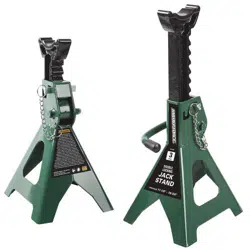Loading ...
Loading ...
Loading ...

Page 7
MAINTENANCE INSTRUCTIONS
• Maintain your equipment. It is recommended
that the general condition of any equipment be
examined before it is used. Keep your
equipment in good repair by adopting a
program of conscientious repair and
maintenance. Have necessary repairs made
by qualified service personnel.
• Follow the maintenance instructions carefully
to keep your equipment in good working
condition. Never perform any maintenance on
the equipment while it is under a load.
Inspection
You should inspect the equipment for
damage, wear, broken or missing parts (e.g.:
pins) and that all components function before
each use. Follow lubrication and storage
instructions for optimum product performance.
Check the climbing pins to make sure that
they are not worn or damaged. Check that
everything is good working condition and that
nothing is blocking the holes. Do not use the
equipment unless it is in good working
condition.
Binding
If the equipment binds while under a load, use
equipment with equal or a larger load capacity
to lower the load safely to the ground. After
un-binding; clean, lubricate and test that
equipment is working properly. Rusty compo-
nents, dirt, or worn parts can be causes of
binding Clean and lubricate the equipment as
indicated in the lubrication section. Test the
equipment by lifting without a load. If the
binding continues, contact Customer Service.
IF YOUR EQUIPMENT BINDS
As your equipment becomes older, the
threads may start binding. This will prevent the
equipment from operating properly and safely.
Rusty threads, dirty threads, or a worn threads
a. All moving parts of the equipment should
be regularly cleaned.
b. Lubricate parts as required by the
manufacturer’s specifications. The type of
lubricant should be as specified by the
manufacturer or a qualified person.
Lubrication systems should be checked to
verify proper operation.
c. If additional maintenance is required, it
should be completed in accordance with the
instructions of the manufacturer or qualified
person.
can cause binding. Clean and lubricate the
lifting mechanism. Test the equipment without
a load. If the binding continues, refer to the
after sale parts and service. If your equipment
binds while under a load, use a equipment
with equal or larger load capacity to lower the
load safely to the ground. Repeat the steps in
this paragraph to the binding equipment.
Cleaning
If the moving parts of the equipment are
obstructed, use cleaning solvent or another
good degreaser to clean the equipment.
Remove any existing rust, with a penetrating
lubricant. Do not use motor oil or grease to
lubricate the equipment.
Rust Prevention
Check daily for any signs of rust or corrosion.
Without a load lift the equipment as high as it
goes and look under and behind the lifting
points. If signs of rust are visible clean as
needed.
Storing the Equipment
1. Store in a dry location, recommended
indoors.
2. Equipment should be stored in an area
where they will not be subjected to damage.
3. If extreme temperatures or chemically
active or abrasive environments are involved,
the guidance provided in shall be followed.
4. Temperature - Whene quipment is used at
temperatures above 140"F (60"C) or below
-20"F (-29"C), the equipment manufacturer or
a qualified person should be consulted.
5. Chemically Active Environments - The
strength and operation of eqipment can be
affected by chemically active environments
such as caustic or acid substances or fumes.
The equipment manufacturer or a qualified
person should be consulted before equipment
are used in chemically active environments.
6. Other Environments - The internal workings
of equipment can be affected by high
moisture, gravel or sand, silt, grit, or other
dust-laden air. Equipment subject to these
environments should have their inner
components frequently cleaned, inspected,
and lubricated.
Note: If the equipment is stored outdoors, be
sure to lubricate all parts before and after use
to ensure the equipment stays in good
working condition.
Loading ...
Loading ...
Loading ...
